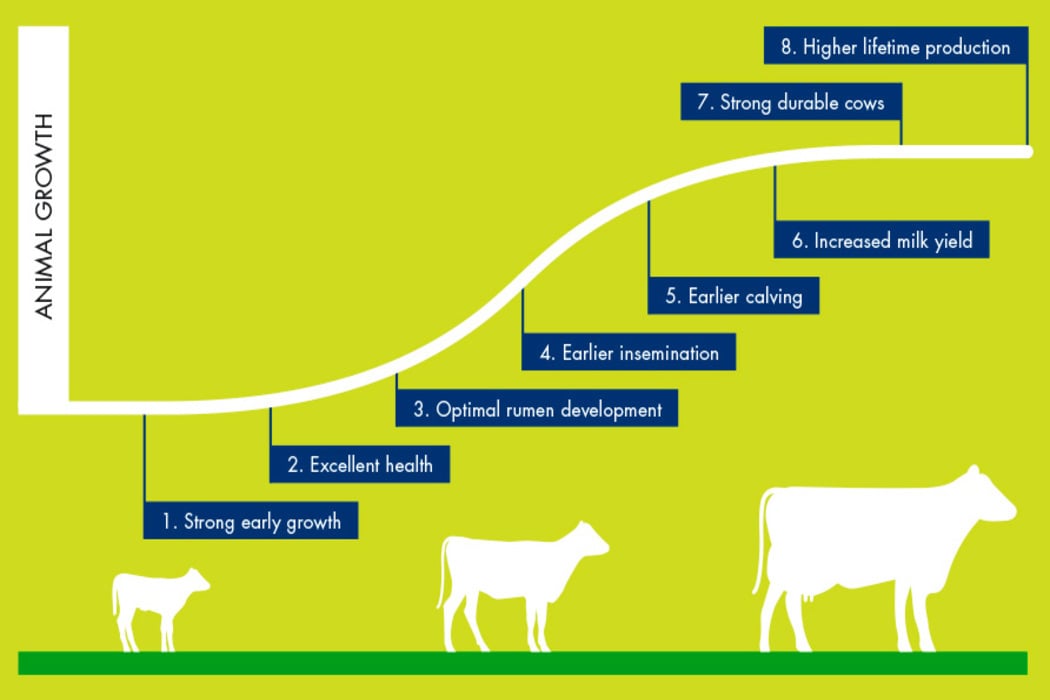
The effect of LifeStart schedules on milk production in the first lactation
The effect of elevated planes of nutrition in dairy calves during the pre-weaning phase on future lactational performance has been studied by several authors[1],[2],[3],[4],[5],[6],[7],[8],[9]. The protocols of these studies varied considerably which explains the variation on subsequent milk production in 1st lactation of the heifers included in these studies. With the exception of 1 study by Morisson et al[3], in which no effect on milk production was found, elevated planes of nutrition always resulted in additional milk production during the first lactation of at least 300 litres.

The effect of LifeStart schedules on
milk production in the first lactation
Reference |
Effect on pre-weaning ADG (gram/day) |
Effect on 1st lactation in litres |
| Shamay et al.[1] | 287 | 981 |
| Faber et al.[2] | 195 | 955 |
| Morrisson et al.[3] | 160 | 0 |
| Davis-Ricker et al.[4] | 197 | 416 |
| Moallem et al.[5] | 70 | 732 |
| Reath-Knight et al.[6] | 230 | 718 |
| Drackley et al.[7] | 146 | 342 |
| Drackley et al.[7] | 226 | 1332 |
| Terré et al.[8] | 96 | 624 |
| Soberon et al.[9] | 355 | 552 |
The Trouw Nutrition Kempenshof trial

Material and methods
A total 86 individually housed female calves were included in a longitudinal study carried out in the Kempenshof[10]. Pairs were fed the same amounts of colostrum from the same source and blocked by colostrum, parity and season. The only difference between the two groups was the amount of calf milk replacer fed. The LifeStart group was fed 8 litres per day compared to 4 litres per day for the controls, both groups were fed at a concentration of 150 g/l.
Results
Average daily gain until weaning in the LifeStart group was 150 g/day extra. This difference in growth resulted in an average increase in production of fat corrected milk that was 400 litres above the production of the controls.
References
[1] Shamay, A., D. Werner, U. Moallem, H. Barash, and I. Bruckental. 2005. Effect of nursing management and skeletal size at weaning on puberty, skeletal growth rate, and milk production during first lactation of dairy heifers. J. Dairy Sci. 88:1460–1469.
[2] Faber, S. N., N. E. Faber, T. C. McCauley, and R. L. Ax. 2005. Case study: Effects of colostrum ingestion on lactational performance. Prof. Anim. Sci. 21:420–425.
[3] Morrison, S. J., H. C. F. Wicks, R. J. Fallon, J. Twigge, L. E. R. Dawson, A. R. G. Wylie, and A. F. Carson. 2009. Effects of feeding level and protein content of milk replacer on the performance of dairy herd replacements. Animal 3:1570–1579.
[4] Davis Rincker LE, VandeHaar MJ, Wolf CA, Liesman JS, Chapin LT and Weber Nielsen MS, Effect of intensified feeding of heifer calves on growth, pubertal age, calving age, milk yield, and economics. J. Dairy Sci 94:3554-3567 (2011).
[5] Moallem, U., D. Werner, H. Lehrer, M. Zachut, L. Livshitz, S. Yakoby, and A. Shamay. 2010. Long-term effects of ad libitum whole milk prior to weaning and prepubertal protein supplementation on skeletal growth rate and first-lactation milk production. J. Dairy Sci. 93:2639–2650.
[6] Raeth-Knight, M., H. Chester-Jones, S. Hayes, J. Linn, R. Larson, D. Ziegler, B. Ziegler, and N. Broadwater. 2009. Impact of conventional or intensive milk replacer programs on Holstein heifer performance through six months of age and during first lactation. J. Dairy Sci. 92:799–809.
[7] Drackley, J. K., B. C. Pollard, H. M. Dann, and J. A. Stamey. 2007. First-lactation milk production for cows fed control or intensified milk replacer programs as calves. J. Dairy Sci. 90(Suppl. 1):614 (Abstr.).
[8] Terré, M., C. Tejero, and A. Bach. 2009. Long-term effects on heifer performance of an enhanced growth feeding programme applied during the pre-weaning period. J. Dairy Res. 76:331–339.
[9] Soberon F, Raffrenato E, Everett RW and Van Amburgh ME. 2012. Preweaning milk replacer intake and effects on long-term productivity of dairy calves. J. Dairy Sci. 95:783-793.
[10] Data on file, Study report R06201A.







